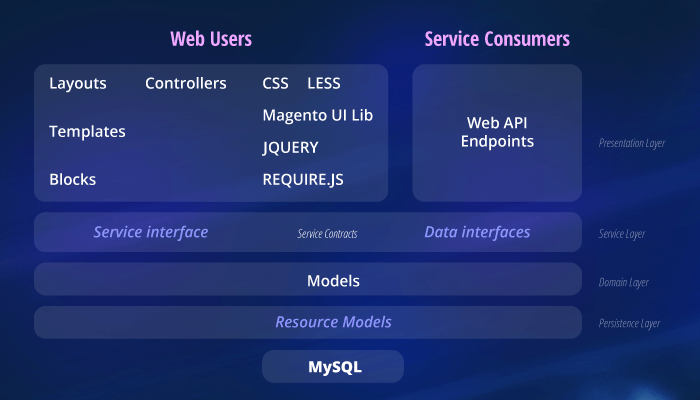-
Product Management
Software Testing
Technology Consulting
-
Multi-Vendor Marketplace
Online StoreCreate an online store with unique design and features at minimal cost using our MarketAge solutionCustom MarketplaceGet a unique, scalable, and cost-effective online marketplace with minimum time to marketTelemedicine SoftwareGet a cost-efficient, HIPAA-compliant telemedicine solution tailored to your facility's requirementsChat AppGet a customizable chat solution to connect users across multiple apps and platformsCustom Booking SystemImprove your business operations and expand to new markets with our appointment booking solutionVideo ConferencingAdjust our video conferencing solution for your business needsFor EnterpriseScale, automate, and improve business processes in your enterprise with our custom software solutionsFor StartupsTurn your startup ideas into viable, value-driven, and commercially successful software solutions -
-
- Case Studies
- Blog
Spree vs Magento Comparison: What’s Best for Your Storefront
Using ready ecommerce platforms to build online stores is great for both startups and enterprise businesses. You can save time, money, and effort with ready platforms since they already offer basic ecommerce functionalities. Ecommerce platforms allow you to concentrate on developing distinctive features for your project. But which platform – Spree or Magento – should you choose? What are the advantages of Magento? What are the benefits of using Spree e-commerce?
Let’s compare these two platforms. Here’s a quick overview:
| Ecommerce Platform | Spree Commerce | Magento |
Project Owner |
First Data |
Permira |
Supported by |
Spark Solutions |
Magento Inc. |
Pricing |
Free |
Free for Community Edition |
Incidental |
Depends on the web development company |
Depends on the web development company |
Latest |
Spree 3.2.0 Release Candidate 1 |
Community Edition 2.1.4, released February 2017 |
Supported Payment Gateways |
PayPal |
PayPal |
Extensions |
60+ extensions |
100+ extensions for Magento 2 and higher |
Technology Stack |
Ruby |
PHP |
This is hardly an exhaustive comparison of two popular ecommerce platforms. We need to scrutinize Magento vs Spree performance (in general) to see the real differences. Let’s dive deeper into the following aspects of these platforms:
- Pricing / subscription options;
- Development complexity;
- Third-party plugins; and
- The future of the platforms.
Spree vs Magento: Pros and Cons of Each Ecommerce Platform
A ready ecommerce platform doesn’t need to cost money. What's the difference between Spree and Magento in this regard? Magento charges a yearly maintenance fee, but Spree Commerce can be truly free. But no matter which platform you work with, you’ll want to create custom UX and UI design, develop additional features, and deploy and support your online store. In other words, there are always incidental costs involved in developing with both solutions.
Let’s begin by comparing the platform costs.
Spree Commerce Pricing
Spree Commerce is truly free, and comes in only one edition. Even the extensions are 100% free. We can use it for $0 to develop as many websites as we like. That’s why we consider only Magento Community Edition a direct competitor to Spree, since it’s also free.
If you opt for Spree Commerce, you’ll pay only for front end customization and additional functionalities you develop on the backend. We’ll mention backend functionalities that we’ve implemented in our projects later, which will help you understand what you’ll end up paying for if you choose this platform.
Magento Pricing
Magento is available in two editions: the Community Edition (CE) is a lightweight, free ecommerce platform; the Enterprise Edition (EE) is costly. The Enterprise Edition provides more functionality out of the box and, supposedly, offers improved performance compared with the Community Edition.
According to the MDN Blog, the maintenance fee for the Enterprise Edition was seriously increased. The latest version of the PHP-based platform now costs at least $22,000 per year, whereas previously it cost a minimum of $18,000. And when net sales of your online store go above $1 million per year, the price for the Enterprise Edition grows higher than $22,000 per year.
The Community Edition and Enterprise Edition require different versions of third-party plugins, which are usually paid (even for the free Community Edition). Extensions for the ecommerce platform are typically priced between $99 and $999, but in some cases can be even more. Therefore, total costs for the Enterprise Edition plus extensions easily exceeds $22,000. Add in the cost of a development team, and you’ll see that developing with the Enterprise Edition is rather expensive.
In short, the Community Edition is a better choice than Enterprise Edition for starting an online store.
The key point: Considering it’s more difficult to develop an ecommerce store with Magento than with Spree (we’ll talk you through the development difficulties in the following section), a Magento-based store will always cost more.
Spree Commerce vs Magento: Development Complexity
Let's dive deeper into the Magento vs Spree comparison in this review – let's discuss the architecture. To build a store with either of these platforms, which have many quirks, developers must have deep knowledge of the platform’s architecture. In this section, we’ll highlight some differences between platform's architectures.
Development Complexity with Spree
The architecture of Spree is simpler than that of Magento due to its smaller codebase. Nevertheless, the structure of this Ruby on Rails storefront is intricate.
The RESTful API is the main component. Spree’s API allows you to work with orders, shipments, products and their specifications, and other basic elements of an online store.

The other five components of the architecture include:
- Frontend for clients;
- Admin panel;
- Command line tools;
- Core (basic components); and
- Spree Sample.
From our experience, we would say that having a well-documented and convenient API is always great. We’ve also been more than satisfied with extensions for this Rails platform. When developing Medshop Express, a Spree-based drugstore, we used the following extensions:
- Spree Static Content to manage Support, About, and other static pages.
- Spree Editor for editing blog posts on the website.
- PayPal Express Checkout to simplify payments via PayPal for Medshop Express clients.
- Spree Social for registration and authorization via Twitter and Facebook.
- Spree Related Products to manage product relations (suggest accessories or related products).
- Spree Active Shipping to find and track shipments (supports FedEx, UPS, and other carriers).
We implemented all typical features for an online store with these extensions. But we also had to develop custom modules to implement bonuses, an affiliate program, and multi-level marketing.
In short, customizing a Spree-based store is relatively easy for experienced developers.
Development Complexity with Magento
The Magento core clocks in at around 8,000,000 lines of code. That’s a lot. The codebase weighs 37.6MB in an archive – twice the weight of Rails-based solution. Magento is hefty, but for good reason: it provides a lot of functionality out of the box.
The architecture consists of four layers, namely Presentation, Domain, Service, and Persistence. Take a look at the schema below to get a general idea of Magento’s architecture:

As we can see, Magento is comprised of many components – fifteen, to be exact. And developers must understand all the dependencies among these components to develop custom modules.
The key point: If you want to create an ecommerce shop with any of these two platforms, you’ll need an experienced development team to support your project. Spree Commerce is easier to understand due to its smaller codebase and fewer architectural components.
Ready Plugins for Ecommerce Stores
We’ve already mentioned the number of extensions available for Spree Commerce and Magento. Let’s look more closely at some third-party plugins for these ecommerce platforms.
Spree Extensions
The Rails-based platform offers around 60+ plugins. But if there’s no extension available for the functionality we want, then we have to develop our own modules. This is a disadvantage.
On the bright side, Spree Commerce is a Ruby on Rails engine (a small Rails application). Therefore, we can couple it with other Rails engines or even integrate it into fully-fledged Rails applications.
Consider it as a building block that we use to ‘assemble’ an online store. Here are other possible building blocks for your online store:
- Refinery CMS for the Content Management System
- Thredded for forums
- The Devise gem for authentication
All the Rails engines listed above are open source solutions. The Ruby on Rails community has developed a great ecosystem of prebuilt tools that we can freely use to build advanced online stores.
Magento Extensions
Magento has a dedicated marketplace with free and paid extensions. These extensions let you add a blog, AJAX-based pagination, Search Engine Optimization tools, or other functionalities to your ecommerce store. There are even web development companies whose entire business model is creating plugins specifically for the Magento platform. AheadWorks, WebText, and MageWorx are the most prominent examples.
With hundreds of Magento plugins to take care of basic functionalities, you can entirely focus on developing unique features for your store. The only issue with this PHP-based platform is fragmentation. As we mentioned earlier, Magento Enterprise Edition and Community Edition require different versions of the same extensions.
The key point: Magento’s ecosystem of extensions is much more robust than Spree’s. But you have to pay for most Magento extensions, some of which are costly. Plus, whenever you upgrade to a newer version, you need to be aware that certain extensions may not be compatible.
Magento vs Spree Commerce: Platform Development
Let's not look at Spree vs Magento difference regarding their updates. It’s crucial for an ecommerce platform to be regularly updated. We always want more features, new technologies, and improved security. And it’s great that Spree Commerce and Magento are both supported by reputable companies.
Spree Commerce Development
Sparks Solutions and Vinsol improve Spree Commerce according to a development roadmap. In Q4 of 2016, Sparks Solutions will begin developing Spree 3.3.
We should note that Bonobos, an ecommerce store and early Spree adopter, forked the 2.4 version as a standalone ecommerce project. Bonobos and several other contributors are now developing Solidus (the name for their project) to provide their own Rails-based ecommerce solution.
It’s unclear which project – Spree Commerce or Solidus – will be the best Rails engine for ecommerce in the near future. But both of these Rails projects are a good choice for developing your storefront today.
Magento Development
Magento Inc. presented Magento 2.1 in 2016. In this latest version of Magento, the developers tried to resolve loading speed issues and reduce complexity. Magento 2 benefited from PHP 7, Elasticsearch, and other modern web technologies.
Despite these improvements, the platform still received a cold reception for several reasons: issues with loading speed remain unresolved, and migrating an online store to a modern platform is difficult even with the Magento Data Migration Tool. Plus, as we noted earlier, not all extensions are compatible with Magento 2.
Magento Inc. will continue developing Magento 1.x until 2019. But if you’re building a new PHP-based ecommerce store you should go with Magento 2.
So What Ecommerce Platform Best for Your Startup?
Both platforms are great options for starting a new ecommerce store project. But they differ in many respects, which makes it difficult to decide between them. Here are our recommendations:
Choose Spree Commerce if:
- You need a simple ecommerce solution.
- You want to rapidly develop your online shop (thanks to the Ruby on Rails framework).
- You want to avoid paying additional fees for Magento Enterprise Edition.
- You want to customize your store in many ways.
Choose Magento Community Edition if:
- You need to use an open source ecommerce platform.
- You want to avoid paying a maintenance fee for Magento Enterprise Edition.
- You want to make many customizations to the Magento core.
Choose Magento Enterprise Edition if:
- You need to launch several storefronts straight away.
- You need a highly advanced online store straight away to concentrate on development of distinctive features of your store.
- You are ready to pay (substantial) amounts of money for the platform and third-party plugins to increase development speed.
That’s basically all you need to know to decide which storefront will be best suited for your project!














